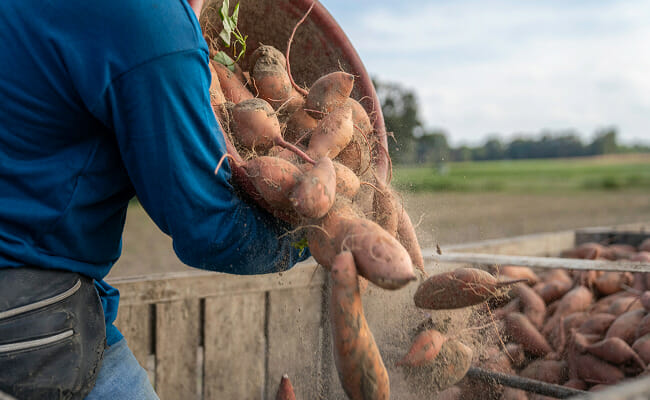How to Grow Sweet Potatoes

It’s time to make room for sweet potatoes in your diet and garden. Whether you’re a pro gardener or a newbie to gardening, you will love this sweet vegetable. Sweet potatoes make impressive trailing houseplants and have fantastic foliage, attracting any garden.
The sweet tuber is a powerhouse vegetable good for your health. It contains essential phytonutrients such as carbohydrates, vitamins, and minerals. It contains vital vitamins such as A, C, E, B5, and B6. In addition, sweet potato is a rich source of potassium, magnesium, and fiber. On top of that, it is an antioxidant that helps prevent cell damage and benefits skin health. Sweet potatoes help energize your mind and body.
Can you grow this nutrient-rich tuber in your garden or a container? Indeed, you can grow sweet potatoes with a dose of patience and sunshine. Depending on the variety, it would take three to four months to grow and harvest sweet potatoes. Scroll down and learn more about growing sweet potatoes in your garden.
What is a sweet potato?
The sweet potato is a tropical plant. They thrive and grow best in sunny weather conditions. They can also endure long dry spells but need to be watered.
You can eat these tubers in a variety of ways. Best enjoy these tubers baked, boiled, raw, or fried like potato fries. You can cook sweet potatoes as a hearty soup or savory casserole. Bake it into bread, cookies, chips, and other yummy desserts. Moreover, you can enjoy them as smoothies and cocktails.
What are the different types?
The ‘Beauregard’ is a popular type that sports pale reddish skin and dark orange flesh. It takes 100 days for this type to reach maturity. Another variety is called ”Bush Porto Rico’ with a distinct copper skin feature and orange flesh and is suitable for smaller gardens.
On the other hand, the ‘Centennial’ cultivar quickly matures after 90 days and is an excellent disease-resistant variety. Another quick maturing tuber is the ‘Georgia Jet’ with reddish skin and orange insides. Just like the Centennial, Georgia Jet tuber matures in 90 days. In addition, an excellent pest-resistant variety is ‘Patriot,’ which is grown primarily in organic gardens.
How to plant sweet potatoes
Home gardeners know it takes a lot of patience to grow vegetables like sweet potatoes. Unlike other vegetables, tubers like sweet potatoes don’t grow from seed. You plant a root or a ‘slip’ to the ground. Sweet potatoes can thrive anywhere, even on poor soil. However, the roots may be deformed when you plant these tubers in this soil. When planting them, consider a well-prepared and suitable environment.
Planting in the garden
Make long and wide 10-inch high ridges with 3.5 feet spacing. The 10-foot row will yield 8-10 pounds of potatoes.
Further prep the soil by adding natural compost. No need to add nitrogen-rich fertilizers, which could produce stunted tubes. For those in the North, best to cover the raised rows with black plastic to keep the soil warm.
Once your soil is ready, plant sweet potato root sprouts, called slips. You can get slips from nurseries, trusted garden suppliers, or mail-order suppliers. Save a couple of roots from your crop for planting next year.
Six weeks before planting, secure root sprouts and put them in a box of moist sand, sawdust, and leaves in a warm place.
It is best to plant in full sun after the last frost. Make 6-inch deep holes 12 inches apart. Put the slips with the top leaves, and press the soil down gently but firmly—one slip per hole with the roots pointing down. The bottom part is covered with dirt while the top position with leaves is above ground. Afterward, water all of them sufficiently.
Planting in a container
Fill your container with top-quality potting soil. Your container should have enough drainage holes.
Make a hole in the soil big enough for the roots or slip. Water well and put your pot in a well-lighted area. Water regularly, but do not overwater.
Growing sweet potatoes indoors is possible but more challenging. Sunlight, heat, and water are needed and harder to replicate.
How to grow sweet potatoes
In just a matter of days after planting, shoots will sprout soon. Here are tips for you to do:
- When shoots reach 6 to 9 inches long, cut them off the root. Remove and throw the bottom inch from each slip to prevent disease organisms.
- Mulch the sweet potato vines to retain moisture and keep the soil loose after planting.\
- Lift longer vines at times to keep them from rooting at the joints. Otherwise, further rooting will result in undersized tubers. You have to prevent this from happening for these tubes to focus on the primary crop at the base of the plant.
- Do not overwater; provide 1 inch of water per week until harvest time. The root crop can withstand long, dry spells. Overwatering them will result to root decay.
- Sweet potatoes mature in 90 to 170 days and are highly frost-sensitive. Remember to plant in the full sun three or four weeks after the last frost when you intend to plant.
Read more: How to plant succulents
Tips on how to remove pests:
Gardeners in the southern areas are more prone to bug issues than in the northern regions.
- Sweet potatoes attract various insects/ There’s the sweet potato weevil, rootworms, white grubs, white-fringed beetles, and flea beetles. From among the insects, sweet potato weevils, 14-inch long insects with reddish-orange bodies and dark blue heads and wings, pierce stems and tubers to lay their eggs.
Adults typically attack vines and leaves while developing larvae tunnel and eat the fleshy roots. Additionally, they propagate foot rot, resulting in brown to black spots on stems close to the soil and at stem ends.
- Use certified disease-resistant slips and follow a four-year crop rotation since weevils proliferate quickly. Discard plants with sick roots and contaminated potatoes.
- To get rid of pests, you may also try using homemade organic bug spray, which you can spray on your plants. Add a combination of dish soap and vinegar to a squirt water bottle.
- Black rot is a fungal disease that causes dark, circular depressions on tubers. Throw away contaminated potatoes from your crop. Next, carefully cure the healthy roots from the same crop.m A fungus called stem rot, sometimes known as wilt, attacks plants that have been harmed by insects, negligent handling, or wind. If the disease does not kill the plants, the yield will be meager and not good quality.
- Plant healthy slips and resistant cultivars to reduce the likelihood of disease and avoid black and stem rot. Maintain a healthy state of fleshy roots between 55 and 60 degrees.
Harvest time
Whether you are a seasoned farmer or a new sweet potato convert, nothing is more satisfying than harvesting your produce. Seeing the fruits of your labor gives you a sweet sense of accomplishment. Here are the steps:
- How can you tell that your sweet potato is ripe for the picking? You will observe that the leaves are turning yellow. If you leave the crop longer, it gets more fortified with vitamins and brings more produce. Try to avoid frost blackening the vines. Otherwise, once the vines turn black, your tubers will go to waste as they will quickly rot. Dig them out before frost sets in. Any nicks on their tender skins will result in spoilage.
- Once you have dug them out, dry them in the sun for several hours. Afterward, put these yummy tubers in a well-ventilated area (85-90 degrees) between 10-15 days for “curing.”
- You cannot just cook a newly-harvested sweet potato. If you do this, you will get a starchy flavor and no sweetness. Curing is a process wherein tubers’ starchy state is broken down into natural sugars. Curing helps the tubers seal their natural moisture and activate enzymes. It helps them reach their full maturity and become naturally sweet. Another six to eight weeks are needed for the curing process to complete.
- Dry these sweet potatoes in the sun for several hours. Afterward, put the tubers in a well-ventilated spot and keep them at 85 to 90 degrees for 10 to 15 days.
After the curing period, store at around 55 degrees, with a humidity of 75 to 80%. Once fully cured, store them in a cool, dark, dry area like a cellar, closet, or basement. You can keep well-cured and stored sweet potatoes for several months.
Conclusion:
It’s high time you include sweet potato as a staple of your diet. The sweet potato is a versatile, no-frills vegetable that is easy to prepare. Its slight edge over its potato cousin is excellent in nutrition, beta-carotene, and vitamin A. Beta carotene is an excellent antioxidant that helps prevent body cells from being damaged. Sweeten your day and get a load of nutrition with every bite of sweet potato.
Read more: Growing food at home – the ultimate step-by-step guide




